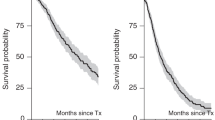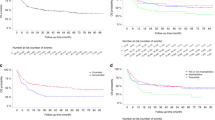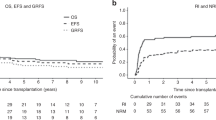Summary:
We compared the results of autologous and allogeneic peripheral blood hematopoietic cell transplant (HCT) in 87 patients with multiple myeloma using myeloablative preparative regimen. Autologous transplant (n=70) led to a lower 100-day transplant-related mortality (TRM) of 4% [0–9%] compared to 18% [0–36%] in allogeneic recipients (P=0.02). More frequent complete responses were seen in allogeneic recipients (64% [37–91%] vs 34% [23–45%] in autologous recipients, P=0.09). In autologous recipients, survival at 1 year was 86% [80–95%] and, it fell to 50% [47–75%] at 4 years, whereas in allogeneic recipients, survival at 1 and 4 years remained at 64% [40–87%]. In patients surviving more than one year, 4-year survival was superior in allogeneic (100%) vs autologous recipients (58% [41–75%], P=0.02). A trend toward higher relapse was seen in autologous transplant patients (73% [55–90%] vs 37% [11–63%] in allogeneic transplant patients, P=0.1). We observed good tolerance of myeloablative conditioning regimen followed by either autologous or allogeneic transplant. Although autologous HCT is associated with lower TRM, allogeneic HCT has acceptable TRM, and is more likely to provide a sustained response. Allogeneic HCT may be suitable in younger patients, soon after diagnosis, and in those with chemosensitive disease.
This is a preview of subscription content, access via your institution
Access options
Subscribe to this journal
Receive 12 print issues and online access
$259.00 per year
only $21.58 per issue
Buy this article
- Purchase on Springer Link
- Instant access to full article PDF
Prices may be subject to local taxes which are calculated during checkout





Similar content being viewed by others
References
Attal M, Harousseau JL, Stoppa AM et al. A prospective randomized trial of autologous transplantation and chemotherapy in multiple myeloma. N Engl J Med 1996; 335: 91–97.
Bjorkstrand B . The European group for blood and marrow transplantation registry studies in multiple myeloma. Semin Hematol 2001; 38: 219–225.
Moreau P, Facon T, Attal M et al. Comparison of 200 mg/m2 melphalan and 8 Gy total body irradiation plus 140 mg/m2 melphalan as conditioning regimens for peripheral blood stem cell transplantation in patients with newly diagnosed multiple myeloma: final analysis of the Intergroupe Francophone du Myelome 9502 randomized trial. Blood 2002; 99: 731–735.
Barlogie B, Jagannath S, Desikan KR et al. Total therapy with tandem transplants for newly diagnosed multiple myeloma. Blood 1999; 93: 55–65.
Attal M, Harousseau JL, Facon T et al. Single versus double autologous stem-cell transplantation for multiple myeloma. N Engl J Med 2003; 349: 2495–2502.
Tricot G, Spencer T, Sawyer J et al. Predicting long term (>or=5 years) event free survival in multiple myeloma patients following planned tandem autotransplants. Br J Haematol 2002; 116: 211–217.
Gahrton G, Svensson H, Cavo M et al. European Group for Blood and Marrow Transplantation. Progress in allogeneic bone marrow and peripheral blood stem cell transplantation for multiple myeloma: a comparison between transplants performed 1983–93 and 1994–98 at the European Group for Blood and Marrow Transplantation centers. Br J Haematol 2001; 113: 209–216.
Bjorkstrand BB, Ljungman P, Svensson H et al. Allogeneic bone marrow transplantation versus autologous stem cell transplantation in multiple myeloma: a retrospective case-matched study from the European Group for Blood and Marrow Transplantation. Blood 1996; 88: 4711–4718.
Maloney DG, Molina AJ, Sahebi F et al. Allografting with non-myeloablative conditioning following cytoreductive autografts for the treatment of patients with multiple myeloma. Blood 2003; 102: 3447–3454.
Arora M, Burns LJ, Barker JN et al. Randomized comparison of G-CSF versus GM-CSF+intensive chemotherapy for peripheral blood stem cell mobilization and autologous transplantation in multiple myeloma. Biol Blood Marrow Transplant 2004; 10: 395–404.
Anderson D, DeFor T, Burns L et al. A comparison of related donor peripheral blood and bone marrow transplants: importance of late-onset chronic graft-versus-host disease and infections. Biol Blood Marrow Transplant 2003; 9: 52–59.
Kaplan EL, Meier P . Nonparametric estimation from incomplete observations. J Am Stat Assoc 1958; 53: 457–481.
Cox DR . Regression models and life tables. J R Stat Soc B 1972; 34: 187–220.
Lin DY . Non-parametric inference for cumulative incidence functions in competing risks studies. Stat Med 1997; 16: 901–910.
Desikan R, Barlogie B, Sawyer J et al. Results of high-dose therapy for 1000 patients with multiple myeloma: durable complete remissions and superior survival in the absence of chromosome 13 abnormalities. Blood 2000; 95: 4008–4010.
Child JA, Morgan GJ, Davies FE et al. High-dose chemotherapy with hematopoietic stem-cell rescue for multiple myeloma. N Engl J Med 2003; 348: 1875–1883.
Segeren CM, Sonneveld P, van der Holt B et al. Overall and event-free survival are not improved by the use of myeloablative therapy following intensified chemotherapy in previously untreated patients with multiple myeloma: a prospective randomized phase 3 study. Blood 2003; 101: 2144–2151.
Author information
Authors and Affiliations
Corresponding author
Rights and permissions
About this article
Cite this article
Arora, M., McGlave, P., Burns, L. et al. Results of autologous and allogeneic hematopoietic cell transplant therapy for multiple myeloma. Bone Marrow Transplant 35, 1133–1140 (2005). https://doi.org/10.1038/sj.bmt.1704968
Received:
Accepted:
Published:
Issue Date:
DOI: https://doi.org/10.1038/sj.bmt.1704968
Keywords
This article is cited by
-
Treatment of newly diagnosed multiple myeloma: advances in current therapy
Medical Oncology (2010)
-
Role of allogeneic stem cell transplantation in multiple myeloma
Current Hematologic Malignancy Reports (2008)
-
Cure of multiple myeloma – more hype, less reality
Bone Marrow Transplantation (2006)



